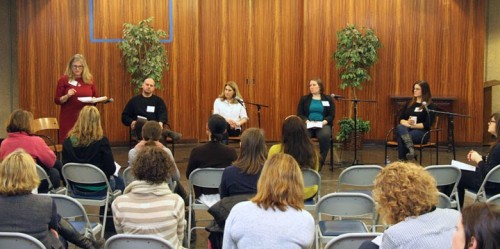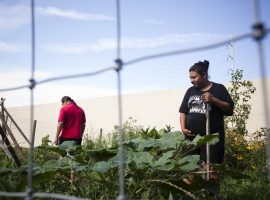 Alison M. Cohen of WhyHunger (left) moderates an expert panel in a conversation about hunger. With Michael Hurwitz of GreenMarket, GrowNYC, Katherine Soll from Teens for Food Justice, Jeanne Traugot of City Harvest, and Cassandra L. Agredo from Xavier Mission. Photo by: Parents Community Service Network
Alison M. Cohen of WhyHunger (left) moderates an expert panel in a conversation about hunger. With Michael Hurwitz of GreenMarket, GrowNYC, Katherine Soll from Teens for Food Justice, Jeanne Traugot of City Harvest, and Cassandra L. Agredo from Xavier Mission. Photo by: Parents Community Service Network
Parents Community Service Network (PCSN), a parent-founded membership organization created to share resources and connect parents who are working on community service projects in their children’s public and private schools around New York City, hosted their second annual parent forum in February. This year’s well-attended forum was aimed at parents and educators looking to engage their students in service projects around hunger. The forum called Beyond the Food Drive: Teaching Kids How to Bring an End to Hunger, was anchored by WhyHunger’s Senior Director of Programs Alison Cohen and featured a diverse set of hunger and food justice leaders as panelists: Cassandra Agredo, Executive Director of Xavier Mission; Michael Hurwitz, Director of Greenmarket at GrowNYC; Katherine Soll, Founder and Executive Director of Teens for Food Justice; and Jeanne Traugot, Manager of Food Sourcing at City Harvest.
Food drives around the holidays are ubiquitous in many schools around the nation and are an important aspect of building awareness about the prevalence of hunger in local communities. Since the recession there has been a significant increase in the need for donated food to local pantries as the growing demand for food assistance has kept stock on the shelves consistently low. And yet food drives are primarily a band-aid approach to the persistence of hunger. PCSN was interested in exploring opportunities for deeper engagement that would help kids explore the root causes of hunger and what can be done to move the dial towards the systemic changes that are ultimately necessary to end hunger. As panelist Cassandra Agredo, Executive Director of Xavier Mission, said, “We are taking care of the problem before it happens” by talking to kids about the reality of hunger early in their lives. Moderated by WhyHunger’s Alison Cohen, panelists spoke about the approaches that each of their organizations takes and continues to evolve that go beyond food drives to include issues of health and nutrition, food production and marketing, and policy change and advocacy. The panelists engaged with audience members to brainstorm innovative ideas for not only involving young students in the fight against hunger today but at the same time providing opportunities for them to have an impact on the root causes of hunger throughout their lives. Here are a few of those suggestions:
Get Physical with the Food. Make the ideas of hunger and poverty tangible so they are easier for children to understand. For example, kids can make sandwiches for a local shelter or deliver food directly to food banks. Instead of canned foods, coordinate with a local pantry to have a fresh food drive and have kids bring in fruits and vegetables that get delivered the same day. Use this as an opportunity to incorporate lessons about the intersection of hunger and health. Go further and involve a local farmer who will brings kids to his or her farm to glean fresh food from the fields that can then be delivered locally to a pantry. Kids might also be able to engage in preserving the food so that it has a longer life on the pantry shelves. Connecting directly to a farmer introduces opportunities to learn about the connection between the environment and healthy food production, as well as lessons about who gets access to the freshest food and why. Having children physically interact with food paints a clearer picture of the multiple reasons why hunger persists and the importance of ensuring that everyone has access to fresh, healthy food.
Re-Think the Drive. There are other ways kids can learn about hunger and poverty besides collecting cans. The Food Stamp Challenge, if taken on by children in concert with their parents, is an experiential way of learning about budgeting and how the Supplemental Nutrition Assistance Program (SNAP) at its current allotment levels is insufficient to provide for the full nutritional needs of an individual or family. The challenge requires that participants attempt to live on the average food stamp benefits allotted to an individual or a family for one week. Detailed records of what was purchased, how much and of what quality informs the reflection and lessons post-challenge. Schools can also “adopt-a-pantry” and build an ongoing relationship in order to respond in real time to the different needs that may arise for a pantry at different times of the year. In addition, the students are afforded an opportunity to learn about how a food pantry operates, to meet the clients, and to participate in the multitude of services and activities the food pantry provides – from distributing food, to engaging in advocacy, to growing food in a garden on-site.
A simple alternative to the food drive is encouraging kids and families to donate money as opposed or in addition to food. For instance, have kids contribute one dollar for every can they bring in. Monetary donations to food pantries and soup kitchens go a lot further than boxes of nonperishable food and provides the flexibility to buy what’s needed. Panelist Cassandra Agredo explained that the purchasing power of pantries is greater than that of consumers. “For the same amount of money it takes the average person to buy one can of beans, [the food pantry] can buy two.”
Broaden the Conversation. Help kids move from discussions on hunger to conversations on food justice, poverty and global inequality. Engage kids in exploring and understanding the root causes of hunger and the systems that perpetuate it. Having conversations about the conditions – economic, environmental, political and more – that lead to hunger in various communities will help kids think through the solutions differently. Let students come up with their own ideas on what to do to deal with the immediate crisis of hunger in their communities while working towards long-term solutions to end hunger. Consider a conversation (or engage in a campaign) about living wage. Take a field trip to a farmers market or a local farm to explore the relationship between access to land and combatting hunger? Panelist Katherine Soll, the Founder and Executive Director of Teens for Food Justice, emphasized the need to avoid an “us vs. them” mentality while encouraging kids to be charitable. She suggested bringing together groups of kids from different schools, grades and socioeconomic backgrounds to explore the issues together. By working directly with children who may be food insecure themselves, students will be less likely to buy into stereotypes about who is hungry and why.
WhyHunger’s Alison Cohen concluded the seminar by encouraging parents and educators to make the distinction between “charity and change” when discussing service projects. Combining both approaches helps children grow up understanding the value of mobilizing now to make contributions that mitigate the short-term effects of hunger while advocating for and implementing system-wide change to get one step closer to ending world hunger for good.
Megan Campbell is a senior at Fordham University and a former Communications Intern at WhyHunger.





